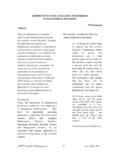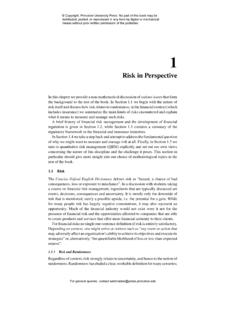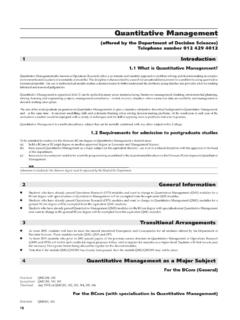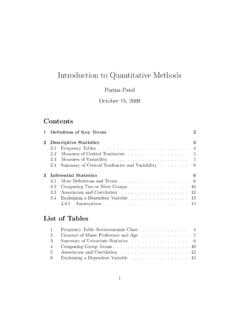Transcription of Solutions Manual to accompany Quantitative Methods
1 Solutions Manualto accompanyQuantitative MethodsAn Introductionfor Business ManagementProvisional version of June 10, 2014 Paolo BrandimarteA Wiley-Interscience PublicationJOHN WILEY & SONS, York / Chichester / Weinheim / Brisbane / Singapore / TorontoContentsPrefacevii1 Quantitative Methods : Should We Bother? Computational supplement: How to solve the optimal mixproblem32 Solutions73 Linear Solutions154 Descriptive Statistics: On the Way to Elementary Solutions255 Probability Additional Solutions of additional problems316 Discrete Random Solutions33vviCONTENTS7 Continuous Random Solutions378 Dependence, Correlation, and Conditional Solutions439 Inferential Solutions4710 Simple Linear Solutions6311 Time Series Solutions6912 Deterministic Decision Solutions7513 Decision Making Under Solutions9114 Advanced Regression Solutions99 Appendix A R A software tool for statistics103 Appendix B Introduction to Working with vectors and matrices in the MATLAB Solving equations and computing Statistics in Using MATLAB to solve linear and quadratic programmingproblems118 Appendix C Introduction to Running optimization models in Mean-variance efficient portfolios in The knapsack model in AMPL125 PrefaceThis Solutions Manual contains worked-out Solutions to end-of-chapter problems in the book additional problems (solved)
2 Computational supplements illustrating the application of the following tools: Microsoft Excel R MATLAB AMPLSome software tools are introduced in the appendices, where I am giving you a few hintsand clues about how they can be used to apply the Methods described in the book. Someof these tools are free, some have free student demos, some can be obtained at a reducedprice. Anyway, they are all widely available and I encourage you to try them. To the veryleast, they can provide us with quantiles from probability distributions, and are much morehandy and precise than using old-style statistical Manual is work-in-progress, so be sure to check back every now and then whether anew version has been version is dated June 10, 2014As usual, for comments, suggestions, and criticisms, my e-mail address is:Paolo Methods : Should We Bother?
3 SOLUTIONSP roblem consider the strategy of trying Plan A first and then Plan B; a morecomplete solution approach should rely on the decision tree framework of Chapter 13 (seeProblem ).Imagine that we are at the end of year 1, and say that the first movie has been a we try Plan B for the second movie, we invest 4000 now, and at the end of the second yearwe will make 6600 with probability + and 0 with probability 1 ( + )= .The expected NPV for this part of the strategy isNPVh= ( + ) 4000 = 6000 1000;note that here we are discounting the cash flow at the end of year 2 back to the end of year1. We go on with Plan B only if this NPV is positive, , 10006000= the other branch of the tree, the first movie has been a flop. The second movie, if weadopt plan B, yields the following NPV (discounted back to the end of year 1):NPVf= ( ) 4000 = 6000 will always be negative for 0, which makes sense: With 50 50 probabilities, thebet is not quite promising, and the situation does not improve after a first flop if this makesthe odds even less favorable, and we dismiss the possibility of producing the second us step back to the root node (beginning of year 1), where we apply Plan A.
4 There,the expected NPV is 2500 + 4400 + + + ,12 Quantitative Methods : SHOULD WE BOTHER?which is positive if condition is more stringent that the previous one. Thus, the conditional probability ofa second hit after the first one should not be less than (which also implies that the theconditional probability of a hit after a first flop is ).Problem than extending the little numerical example of Chapter 1, let usstate the model in general form (also see Chapter 12):maxN i=1(pi ci)xi, i=1rimxi Rm,m=1,..,M,0 xi di,i=1,..,N,where: Items are indexed byi=1,..,N Resources are indexed bym=1,..,M di,pi, andciare demand, selling price, and production cost, respectively, for itemi rimis the unit requirement of resourcemfor itemi, andRmis the total availabilityof resourcemIn this model, we have a single decision variable,xi, representing what we produceandsell.
5 If we introduce the possibility of third-party production, we can no longer identifyproduction and sales. We need to change decision variables as follows: xiis what we produce yiis what we buyWe could also introduce a variablezito denote what we sell, but sincezi=xi+yi, we canavoid us denote bygi>cithe cost of purchasing itemifrom the third-partysupplier. The model is nowmaxN i=1[(pi ci)xi+(pi gi)yi] i=1rimxi Rmm=1,..,Mxi+yi dii=1,..,Nxi,yi 0i=1,..,N1 However, in multiperiod problems involving inventory holding we do need such a variable; see Chapter SUPPLEMENT: HOW TO SOLVE THE OPTIMAL MIX PROBLEM3If we allow for overtime work, we change the first model by introducing the amount ofovertimeOmon resourcem, with costqm:maxN i=1(pi ci)xi M m= i=1rimxi Rm+Om,m=1,..,M,0 xi di,i=1,..,N,Om 0,m=1.
6 , are just naive models used for introductory purposes. In practice, we should (atthe very least) account for limitations on overtime work, as well as fixed charges associatedwith purchasing COMPUTATIONAL SUPPLEMENT: HOW TO SOLVE THE OPTIMAL MIXPROBLEMIn this section we show how different software tools can be used to solve the optimal mixproblem of Section first alternative is using MATLAB (see Section in the Appendix):>> m = [45, 60];>> reqs = [ 15 10; 15 35; 15 5; 25 15];>> res = 2400*ones(4,1);>> d = [100, 50];>> x = linprog(-m, reqs, res, [], [], zeros(2, 1), d)Optimization , with MATLAB we cannot solve integer programming problems. To thisaim, we may use AMPL (see Appendix C). We need a model file and a data file, whosecontent is illustrated in Fig. Using the CPLEX solver with AMPL, we findampl: model ;ampl: data ;ampl: solve;CPLEX : optimal integer solution; objective 55052 MIP simplex iterations0 branch-and-bound nodes1 Gomory cutampl: display x;x [*] :=173237;If we omit theintegerkeyword in the definition of decision variablex, we obtain thesame solution as Methods : SHOULD WE BOTHER?
7 # NumItems > 0;param NumResources > 0;paramProfitContribution{ };param MaxDemand{ };param ResReqs{ , };param ResAvail{ };var x{i in } >= 0, <= MaxDemand[i], integer;maximize profit:sum {i in } ProfitContribution[i] * x[i];subject to Capacity {j in }:sum {i in } ResReqs[i,j] * x[i] <= ResAvail[j];param NumItems := 2;param NumResources := 4;param: ProfitContribution MaxDemand :=1 45 1002 60 50;param ResAvail := default 2400;param ResReqs:1234:=1 15 15 15 252 10 35 5 15;Fig. model ( ) and data ( ) files for product mix widespread tool that can be used to solve (small) LP and MILP models isMicrosoft Excel, which is equipped by a Solver directly interfaced with the is a double-edged sword, since it means that the model must be expressed in a two-dimensional array of cells, where data, constraints, and the objective function must be linkedone to another by product mix problem can be represented as in , as shownin Fig.
8 The cellProfitcontain the profit contribution and the cellsRequiredare usedto calculate the resource requirements as a function of the amounts produced, which are thecontents of the cellsMake. It is important to name ranges of cells to include them in themodel in a readable model is described by opening the Solver window and specifying decision variables,constraints, and the objective cell as illustrated in Fig. fig:ProdMixExcel2. As you see,reference is made to named cell ranges; the cells containing<=in the worksheet have nomeaning, actually, and are only included to clarify the model should make sure that the Solver was included in your Excel installation; sometimes, it is not includedto save space on SUPPLEMENT: HOW TO SOLVE THE OPTIMAL MIX PROBLEM5 Fig. to solve the optimal product mix one can imagine, describing and maintaining a large-scale model in this form mayquickly turn into nightmare (not taking into account the fact that state-of-the-art solversare needed to solve large problem instances).
9 Nevertheless, Excel can be used to solve smallscale models and is in fact the tool of choice of many management Science books. We shouldmention, however, that the true power of Excel is its integration with VBA (Visual Basicfor Application), a powerful programming language that can be used to develop remarkableapplications. A clever strategy is to use Excel as a familiar and user-friendly interface, andVBA to build a link with state-of-the-art software Methods : SHOULD WE BOTHER?Fig. for SOLUTIONSP roblem first requirement for functionf(x) is that the argument of the squareroot is positive:1 x2 0 1 x 1 Then, the denominator of the ratio cannot be zero: 1 x26=1 x6=0 Then, the domain offis [ 1,0) (0,1].The square root in functiong(x) is not an issue, asx2+16= 0. We also observe that thedenominator is never zero, since x2+1=x x2+1=x2 1=0which is false.
10 Then, the domain ofgis the whole real first line is easy to find using the formy=mx+qy= 3x+10 For the second one, we use the formy y0=m(x x0)y 4=5(x+2) y=5x+14 For the third line, we observe that its slope ism=3 ( 5)1 3= 4 Then we havey 3= 4(x 1) y= 4x+778 CALCULUSA lternatively, we might also consider its parametric form{y= ya+(1 )yb=3 5(1 )x= xa+(1 )xb= + 3(1 )and eliminate between the two equations. This approach is less handy, but it stressesthe idea of a line as the set ofaffine combinationsof two vectors. An affine combination ofvectors is a linear combination whose weights add up to one (see Chapter 3).Problem 1(x)=3 (x2+1) 3x 2x(x2+1)2=3(3x2+1)(x2+1)2f 2(x)=(3x2 2x+5)ex3 x2+5x 3f 3(x)=12 exp(x+2x 1) exp(x+2x 1) 3(x 1)2 Problem us start withf(x)=x3 x. We observe the following: Limits:limx f(x)= ,limx + f(x)=+ Roots: we havef(x) = 0 forx(x2 1)=0 x=0,x= 1 The first order derivativef (x)=3x2 1 is zero forx= 1/ 3 , positiveforx< 1/ 3 andx>1/ 3, negative otherwise.}










